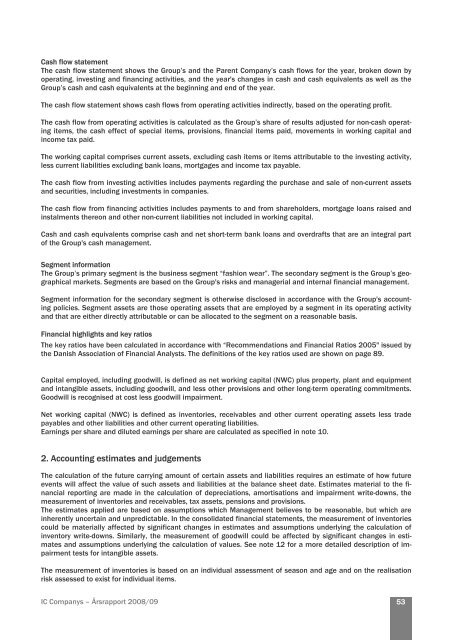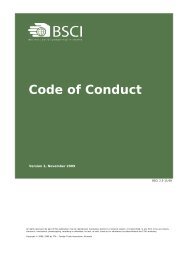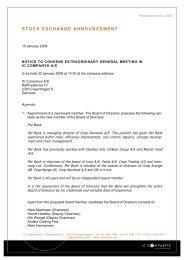IC Companys â Annual Report 2008/09 0 - IC Companys A/S
IC Companys â Annual Report 2008/09 0 - IC Companys A/S
IC Companys â Annual Report 2008/09 0 - IC Companys A/S
Create successful ePaper yourself
Turn your PDF publications into a flip-book with our unique Google optimized e-Paper software.
Cash flow statement<br />
The cash flow statement shows the Group’s and the Parent Company’s cash flows for the year, broken down by<br />
operating, investing and financing activities, and the year's changes in cash and cash equivalents as well as the<br />
Group’s cash and cash equivalents at the beginning and end of the year.<br />
The cash flow statement shows cash flows from operating activities indirectly, based on the operating profit.<br />
The cash flow from operating activities is calculated as the Group’s share of results adjusted for non-cash operating<br />
items, the cash effect of special items, provisions, financial items paid, movements in working capital and<br />
income tax paid.<br />
The working capital comprises current assets, excluding cash items or items attributable to the investing activity,<br />
less current liabilities excluding bank loans, mortgages and income tax payable.<br />
The cash flow from investing activities includes payments regarding the purchase and sale of non-current assets<br />
and securities, including investments in companies.<br />
The cash flow from financing activities includes payments to and from shareholders, mortgage loans raised and<br />
instalments thereon and other non-current liabilities not included in working capital.<br />
Cash and cash equivalents comprise cash and net short-term bank loans and overdrafts that are an integral part<br />
of the Group's cash management.<br />
Segment information<br />
The Group’s primary segment is the business segment “fashion wear”. The secondary segment is the Group’s geographical<br />
markets. Segments are based on the Group's risks and managerial and internal financial management.<br />
Segment information for the secondary segment is otherwise disclosed in accordance with the Group's accounting<br />
policies. Segment assets are those operating assets that are employed by a segment in its operating activity<br />
and that are either directly attributable or can be allocated to the segment on a reasonable basis.<br />
Financial highlights and key ratios<br />
The key ratios have been calculated in accordance with “Recommendations and Financial Ratios 2005" issued by<br />
the Danish Association of Financial Analysts. The definitions of the key ratios used are shown on page 89.<br />
Capital employed, including goodwill, is defined as net working capital (NWC) plus property, plant and equipment<br />
and intangible assets, including goodwill, and less other provisions and other long-term operating commitments.<br />
Goodwill is recognised at cost less goodwill impairment.<br />
Net working capital (NWC) is defined as inventories, receivables and other current operating assets less trade<br />
payables and other liabilities and other current operating liabilities.<br />
Earnings per share and diluted earnings per share are calculated as specified in note 10.<br />
2. Accounting estimates and judgements<br />
The calculation of the future carrying amount of certain assets and liabilities requires an estimate of how future<br />
events will affect the value of such assets and liabilities at the balance sheet date. Estimates material to the financial<br />
reporting are made in the calculation of depreciations, amortisations and impairment write-downs, the<br />
measurement of inventories and receivables, tax assets, pensions and provisions.<br />
The estimates applied are based on assumptions which Management believes to be reasonable, but which are<br />
inherently uncertain and unpredictable. In the consolidated financial statements, the measurement of inventories<br />
could be materially affected by significant changes in estimates and assumptions underlying the calculation of<br />
inventory write-downs. Similarly, the measurement of goodwill could be affected by significant changes in estimates<br />
and assumptions underlying the calculation of values. See note 12 for a more detailed description of impairment<br />
tests for intangible assets.<br />
The measurement of inventories is based on an individual assessment of season and age and on the realisation<br />
risk assessed to exist for individual items.<br />
<strong>IC</strong> <strong>Companys</strong> – Årsrapport <strong>2008</strong>/<strong>09</strong><br />
53








